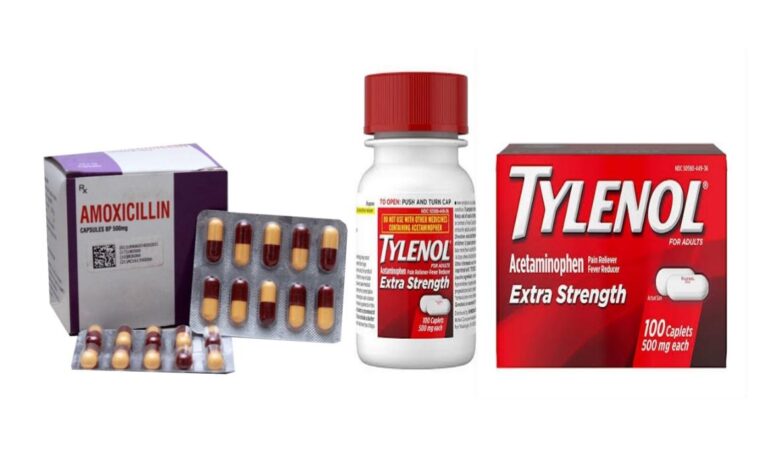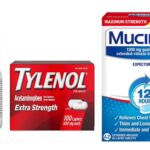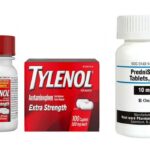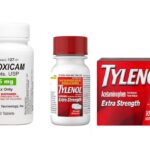Can You Take Tylenol With Amoxicillin Together?

Mixing any combination of prescription drugs, over-the-counter drugs can be unpredictable and dangerous. Most fatal overdoses involve the use of more than one type of drug (poly-drug use).
Poly-drug use is dangerous because different drugs act on our bodies in different ways. The harmful effects are magnified by using more than one drug type.
What is Tylenol?
Tylenol also known as acetaminophen is a medication that relieves mild-to-moderate pain, headache, and fever. You can use acetaminophen to relieve mild or moderate pain. This is usually pain from colds, sore throats, headaches, body or muscle aches, menstrual cramps, arthritis, or toothaches. You can also use it to reduce fever.
It’s not fully known how acetaminophen works. It doesn’t reduce swelling or inflammation. Instead, it’s thought that it blocks the release of certain chemicals in your brain that signal the sensation of pain.
What is Amoxicillin?
Amoxicillin (Amoxiclin) is a penicillin antibiotic that fights bacteria. Amoxicillin is used to treat many different types of infection caused by bacteria, such as tonsillitis, bronchitis, pneumonia, and infections of the ear, nose, throat, skin, or urinary tract.
Amoxicillin is also sometimes used together with another antibiotic called clarithromycin (Biaxin) to treat stomach ulcers caused by Helicobacter pylori infection. This combination is sometimes used with a stomach acid reducer called lansoprazole (Prevacid).
Can you take Tylenol with Amoxicillin?
Yes, it is okay to take over-the-counter painkillers such as Tylenol while you’re taking amoxicillin, assuming these are appropriate for you.
It’s safe to use Tylenol at the same time as taking most antibiotics. Taking antibiotics at the same time as Tylenol shouldn’t cause any problems, but you should always discuss with your doctor before combining medications.
How should I take Tylenol?
Take only one product that contains acetaminophen at a time. Acetaminophen is in many products and you could accidentally take too much if you’re using more than one product at the same time. Acetaminophen can be used by all age groups in recommended doses.
Children (general): The dose of acetaminophen for children is based on body size. Usually, it is calculated as 10 mg to 15 mg per kilogram of body weight, every 4 to 6 hours. No more than 65 mg/kg should be given in a 24-hour period. Children should not take more than 5 doses in 24 hours unless advised by a doctor. For children under 6 months of age, consult a doctor.
Children’s liquid medications should be given using a calibrated dosing device, such as an oral syringe. This ensures that you are giving your child the right amount. Some formulations of liquid acetaminophen contain different concentrations of acetaminophen. Pay careful attention to the concentration on the label and the calculated dose volume.
Adults: The dose of acetaminophen for adults is 325 mg to 650 mg every 4 to 6 hours. Do not take more than 4,000 mg in a 24-hour period. If you are taking the extended-release caplets, the recommended dose for adults and children over 12 years is 1300 mg taken every 8 hours.
Acetaminophen products available without a prescription should not be used for longer than 5 days in a row for pain or 3 days in a row for fever. If you consume 3 or more alcoholic drinks in a day, do not take acetaminophen products, as your risk of liver damage is increased.
Many things can affect the dose of medication that a person needs, such as body weight, other medical conditions, and other medications. If your doctor has recommended a dose different from the ones listed here, do not change the way that you are taking the medication without talking to your doctor. Always take acetaminophen exactly as prescribed by your doctor.
How should I use amoxicillin?
The recommended adult dose of amoxicillin varies widely depending on the age group and the condition being treated, but the medication is usually taken 3 times daily, once every 8 hours. Amoxicillin can be taken with or without meals. Finish all this medication, even if you have started to feel better. This will reduce the chance of the infection returning and being harder to treat.
For the liquid form of amoxicillin, use an oral syringe to measure each dose of the liquid, as it gives a more accurate measurement than household teaspoons. Many things can affect the dose of a medication that a person needs, such as body weight, other medical conditions, and other medications. If your doctor has recommended a dose different from the ones listed here, do not change the way that you are taking the medication without consulting your doctor.
It is important to take this medication exactly as prescribed by your doctor. If you miss a dose, take it as soon as possible and continue with your regular schedule. If it is almost time for your next dose, skip the missed dose and continue with your regular dosing schedule. Do not take a double dose to make up for a missed one. If you are not sure what to do after missing a dose, contact your doctor or pharmacist for advice.





